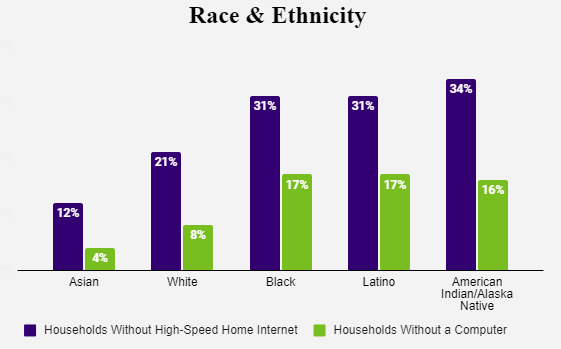The data used for the analysis presented in “Students of Color Caught in the Homework Gap” comes from the 2018 American Community Survey (ACS). This survey, conducted by the U.S. Census Bureau, contacts 3.5 million households per year. Households receive notices through the mail that they have been selected for the survey, and they can respond through the mail, using the internet, or by telephone. If contacted households do not respond, ACS follows up with phone calls to ask that the survey be completed. About 90 percent of contacted households complete the ACS.
The large sample size of ACS allows analysis of fairly disaggregated geographic units. Since the ACS is an ongoing survey, the Census Bureau aggregates the data in different ways. For analysis of census tracts, which generally have populations of about 4,000 people (although census tracts can be geographically large in rural areas), ACS aggregates data over five years. That means that about 17.5 million households are available for analysis. For larger geographic areas such as states, the “1-year ACS estimates” are appropriate, since that survey can be used to analyze places with populations of 65,000 or more.
To calculate the numbers of children without digital tools, this analysis used ACS data on the number of related children in the household. That figure varies depending on income, race, and state. The calculations in the state-by-state tables account for these variations. For example, households in Texas, on average, have more children than those in Vermont, while low-income households generally have more children than upper-income ones. In other words, a separate figure for the average number of children in households was calculated for each state and, within each state, across income and race/ethnicity categories. The ACS downloadable PUMS data does not capture all children in the United States, but the ACS provides data on the total number of children in the country. The number of children in the ACS PUMS data differs from the total reported on the Census website by about 7 percent. The analysis allocated this difference proportionately across states and subcategories.




